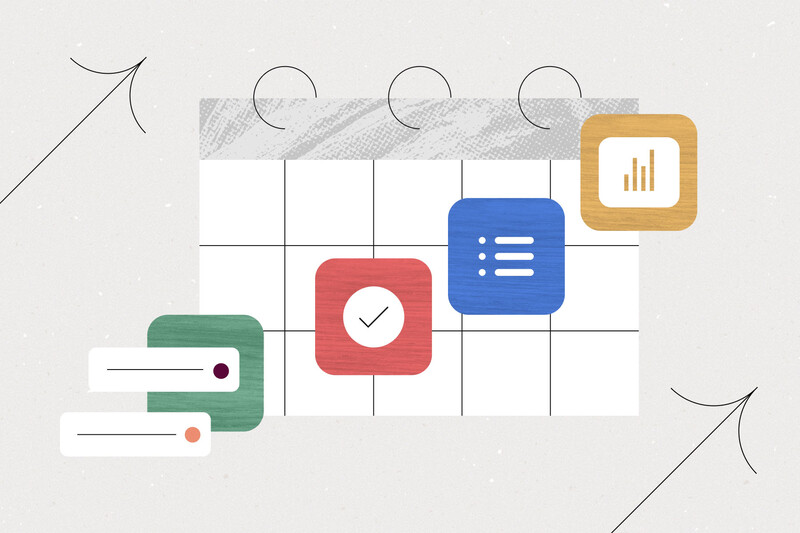In this guide, we will share the easiest way to build a dashboard, even if you’re not a technical person. With our method, you won’t need any help from your technical team. Let’s dive in!
A Good Dashboard: Simple, Interactive, and User-Friendly
Building a good dashboard doesn’t require rocket science. It just needs to be clean, interactive, and user-friendly, supporting the objectives of forward-thinking businesses. However, there are certain principles or steps to consider if you want to design a stunning dashboard.
Let’s go through these steps one by one.
#1. Decide on the Goal of Creating Dashboards
Before actually building your dashboard, you must answer three important questions:
- For whom are you doing this?
- How are you going to approach it?
- What are you expecting out of it?
First and foremost, if you’re planning to share a dashboard with your team, keep your team in mind. They will be the ones using the dashboard to analyze data. Put yourself in their shoes and visualize how they will access your dashboard. Let your dashboard serve a purpose for your team, providing clear information from messy data.
Next, you need to figure out why you’re doing this and what outcomes you expect. Consider the key performance indicators (KPIs) and metrics that will add value to your goals. Revolve your dashboard around questions like:
- What needs to be measured?
- Who will measure it?
- What is the time interval to be measured?
Frequently answering such questions allows you to make purpose-driven decisions and collect, analyze, and measure data effectively.
#2. Identify Your Data Sources
Data collection is an integral part of creating a good dashboard, but it can be overwhelming and time-consuming. There are two kinds of data sources: internal and external.
Internal data sources are within your organization, such as company databases and reports. External data sources are from third-party platforms or tools, like customer data collected from outside the organization.
Identify the source of data you are accumulating and ensure its accuracy and reliability. Prepare a list of data sources, whether they are social platforms or Excel spreadsheets, and keep track of all the sources you use to pull data into your dashboard.
#3. Choose the Right Chart Type
Choosing the right data visualizations and chart types is crucial for displaying your real-time data in an accessible and understandable manner. Different chart types serve different purposes and have varying degrees of effectiveness.
Common chart types include line charts, bar charts, pie charts, sparklines, scatterplots, and gauge charts. Each chart type has its own strengths and is suitable for different types of data and analysis.
Choose the chart type that best represents your KPIs and metrics. Ensure that your chart type effectively communicates the information you want to convey.
#4. Define What Metrics You Want to Track
Key performance indicators (KPIs) summarize your data and present them as actionable insights on your dashboard. These indicators gauge your performance against your goals.
Consider the KPIs that align with your business goals. They can be customer KPIs, operational KPIs, financial KPIs, marketing KPIs, or sales KPIs. Purpose-driven KPIs allow you to analyze what’s working and what’s not, aligning your daily operations with your long-term goals.
#5. Pick Your Colors When Building Dashboards
Colors play an important role in dashboard design. Your dashboard should have the right blend of colors to make it easy to understand and attractive to the eyes. Pick a color combination that fits your business identity or choose a completely different color palette.
Stay consistent with 2-3 color combinations throughout your design. Avoid excessive use of highly saturated colors, high-tone color pixels, and using poles-apart colors to display similar metrics.
#6. Ensure Your Dashboards are Mobile-Optimized
Optimizing your dashboards for mobile devices is essential in today’s mobile-centric world. With billions of mobile phone users globally, remote access to critical metrics is crucial for managing your business.
Optimize your dashboard layout for mobile devices. Use mobile-friendly dashboard templates and prioritize the most important metrics. Consider the “Big Finger Element” and “Thumb-scrolling principle” to enhance user-friendly experience on mobile devices.
#7. Onboard Your Team Members
A good dashboard design involves team onboarding and collaboration. Even with a well-presented dashboard, a dedicated team is required to measure, analyze, and determine outcomes from complex databases.
Make it easy to onboard and share dashboards with your team. Allow them to view, rearrange, and edit data in real time. Encourage feedback and suggestions from your team to improve your dashboard design.
#8. Communicate with Your Team Around Your KPIs
Communication around KPIs is essential for a collaborative work culture. A good dashboard allows your team to communicate and collaborate in real time. Provide a seamless platform for discussions and feedback related to specific metrics.
Datapad: Keep all Your Dashboards in Your Pocket
Datapad is a pocket-friendly dashboarding tool that allows business users to collect, measure, analyze, and visualize crucial KPIs from their mobile phones. The platform offers a highly responsive mobile dashboarding experience, enabling you to manage your business performance from anywhere in the world.
With Datapad, you can easily onboard your team members, communicate in real time, and stay updated with push notifications. Customize your dashboards, choose the right chart types, and track your KPIs effortlessly.
Start building your stunning dashboards with Datapad today! Business






![How to Use LinkedIn for Business [2024 Guide]](https://business.thegioikemchongnang.com/wp-content/uploads/2024/06/how-to-use-linkedin-for-business.png)